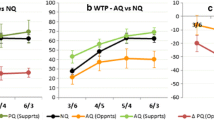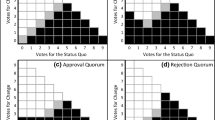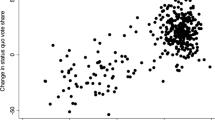Abstract
Meetings of shareholders, societies, and clubs often require a minimal participation quorum. In the absence of a quorum, no valid decisions can be made; thus, decisions are postponed to a later meeting. This paper examines the effect of such quorum constraints on both individual behavior and collective outcomes in a model of costly meetings. We show that when a binding quorum constraint delivers an immediate decision, it also induces a welfare loss with respect to the outcome that prevails when no quorum applies, potentially including policy distortions. When the quorum requirement is high and causes the decision to be postponed, the number of participants in the (second) meeting may decrease with respect to the zero-quorum rule.


Similar content being viewed by others
Notes
Our work also relates to the voluminous literature on public choice about the positive and normative properties of alternative voting rules and the search for an “optimal majority” (see Mueller 2003 for a comprehensive survey of that literature).
For other applications of Osborne et al. (2000), see, for example, Aragonès and Sánchez-Páges (2009), who study how participatory democracies operate and the implications of this process on the behavior of citizens and politicians and the final policy outcomes. For a further discussion about the main aspects of institutions of direct democracy that include initiatives and referendums, see Matsusaka (2005a, 2005b).
Although we focus on a case with uniformly distributed individual ideal policies, our results would still hold for any other symmetric distribution.
The choice of the median as the compromise function seems natural, as it has the special feature of being the only policy not defeated by any other policy in majority-rule, two-way contests. If we were to assume other compromise functions, it would not alter our results qualitatively. For example, if the chosen policy is the mean of the attendees’ ideal points (i.e., \(\overline{x}_{A}=\frac {1}{|A|}\sum_{i=1,\, i\in A}^{|A|}x_{i}\)), the structure of the equilibrium remains the same, as do the effects of introducing a quorum, although the equilibrium number of attendees may be smaller than that in the case of the median.
This quorum protocol is relevant because it applies to many real world situations. For instance, ordinary shareholder meetings in several countries follow such a quorum protocol: in France, a 25 % quorum applies in the first meeting and is no longer required afterwards. Similarly, in Italy, the first quorum rule is set at 50 %, in Greece at 20 %, and in Lithuania at 50 %. While a quorum rule is obligatory in most European countries, its level can be set in the statute of the firm Dornseifer 2005.
We analyze, w.l.o.g., the decision of the individual with ideal point x e , while the same holds for the individual with ideal point 1−x e , that is, the “mirror extremist on the left”.
Notice that here, too, as \(Q>|A_{0}^{*}|\geqslant|A_{2}^{*}|\), the non-emptiness of the set of potential free-riders in the second meeting is guaranteed.
We analyze, w.l.o.g., the individual located at \((\frac{Q-1}{2})d\). Had we analyzed the mirror individual with respect to one-half, we would have obtained a possible symmetric distortion where the policy would be located at \(1-(\frac {Q-1}{2})d\).
Note that if the individual located at x N =1 is himself a free-rider in the second meeting, he unambiguously has the highest incentive to exit to postpone the meeting. Moreover, in that case, x e =1, it holds that β 3<β 4, and hence to avoid postponing the meeting it is sufficient that β⩽β 3.
References
Aguiar-Conraria, L., & Magalhães, P. (2010a). How quorum rules distort referendum outcomes: evidence from a pivotal voter model. European Journal of Political Economy, 26(4), 541–557.
Aguiar-Conraria, L., & Magalhães, P. (2010b). Referendum design, quorum rules and turnout. Public Choice, 144(1), 63–81.
Aragonès, E., & Sánchez-Páges, S. (2009). A theory of participatory democracy based on the real case of Porto Alegre. European Economic Review, 53(1), 56–72.
Besley, T., & Coate, S. (1997). An economic model of representative democracy. Quarterly Journal of Economics, 112(1), 85–114.
Black, D. (1958). The theory of committees and elections. Cambridge: Cambridge University Press.
Bulkley, G., Myles, G., & Pearson, B. (2001). On the membership of decision-making committees. Public Choice, 106(1), 1–22.
Dornseifer, F. (2005). Corporate business forms in Europe: a compendium of public and private limited companies in Europe. Munich: Sellier European Law Publishers.
Downs, A. (1957). An economic theory of democracy. New York: Harper & Row.
Herrera, H., & Mattozzi, A. (2009). Quorum and turnout in referenda. Journal of the European Economic Association, 8(4), 838–871.
Houy, N. (2009). A characterization of majority voting rules with quorums. Theory and Decision, 67(3), 295–301.
Ledyard, J. (1981) The paradox of voting and candidate competition: a general equilibrium analysis. G. Horwich & J. Quirck (Eds.), Essays in contemporary fields of economics. West Lafayette: Purdue University Press.
Ledyard, J. (1984). The pure theory of large two-candidate elections. Public Choice, 44(1), 7–41.
Maniquet, F., & Morelli, M. (2010). Approval quorums dominate participation quorums. Working Paper, Series EUI ECO, 2010/13.
Matsusaka, J. G. (2005a). Direct democracy works. Journal of Economic Perspectives, 19(2), 185–206.
Matsusaka, J. G. (2005b). The eclipse of legislatures: direct democracy in the 21st century. Public Choice, 124(1), 157–177.
Mueller, D. (2003). Public choice III. Cambridge: Cambridge University Press.
Osborne, M., & Slivinski, A. (1996). A model of political competition with citizen-candidates. Quarterly Journal of Economics, 111(1), 65–96.
Osborne, M., Rosenthal, J., & Turner, M. (2000). Meetings with costly participation. American Economic Review, 90(4), 927–943.
Palfrey, T., & Rosenthal, H. (1983). A strategic calculus of voting. Public Choice, 41(1), 7–53.
Palfrey, T., & Rosenthal, H. (1985). Voter participation and strategic uncertainty. American Political Science Review, 79(1), 62–78.
Riker, W., & Ordeshook, P. (1968). A theory of the calculus of voting. American Political Science Review, 62(1), 25–42.
Acknowledgements
We are very grateful to the editor, an associate editor, and two anonymous referees who provided many helpful comments. We would also like to thank Enriqueta Aragonès, Caterina Calsamiglia, Salvador Barberà, Helios Herrera, Humberto Llavador, Andrea Mattozzi, Clara Ponsatí, and Dimitrios Xefteris. All remaining errors are our own.
Author information
Authors and Affiliations
Corresponding author
Appendix
Appendix
All proofs can be found on the authors’ website.
Rights and permissions
About this article
Cite this article
Flamand, S., Troumpounis, O. Participation quorums in costly meetings. Public Choice 159, 53–62 (2014). https://doi.org/10.1007/s11127-012-0013-2
Received:
Accepted:
Published:
Issue Date:
DOI: https://doi.org/10.1007/s11127-012-0013-2




